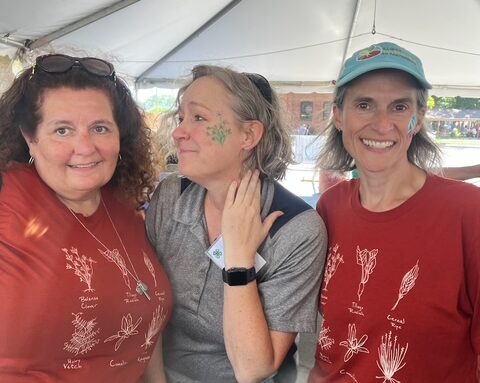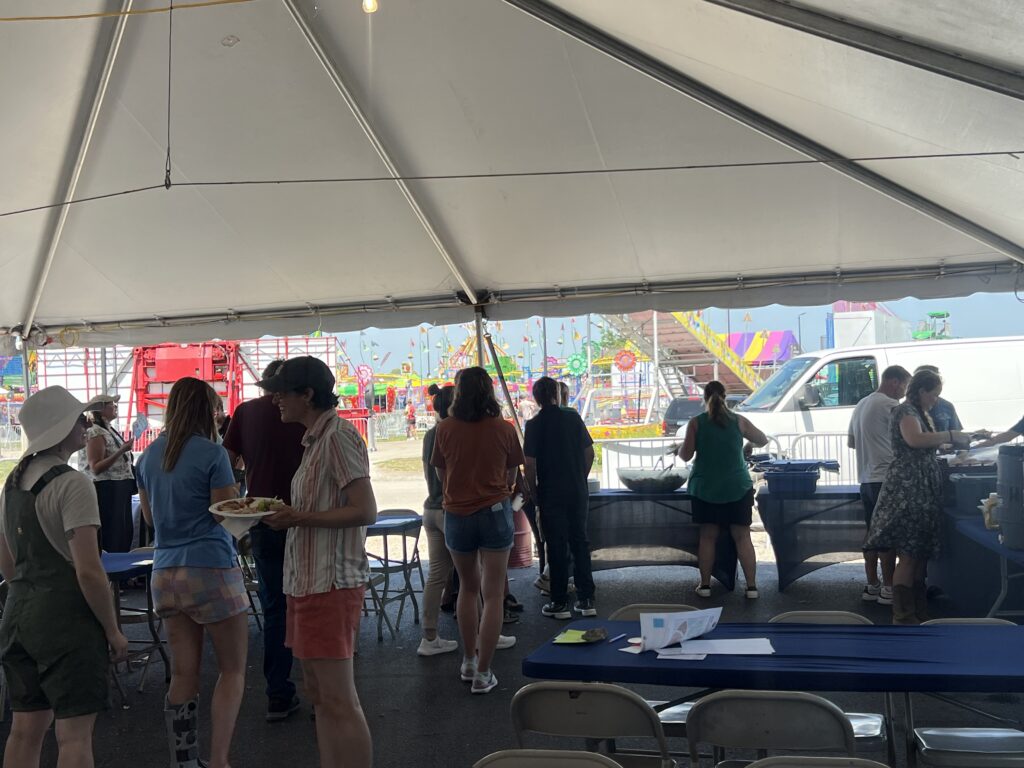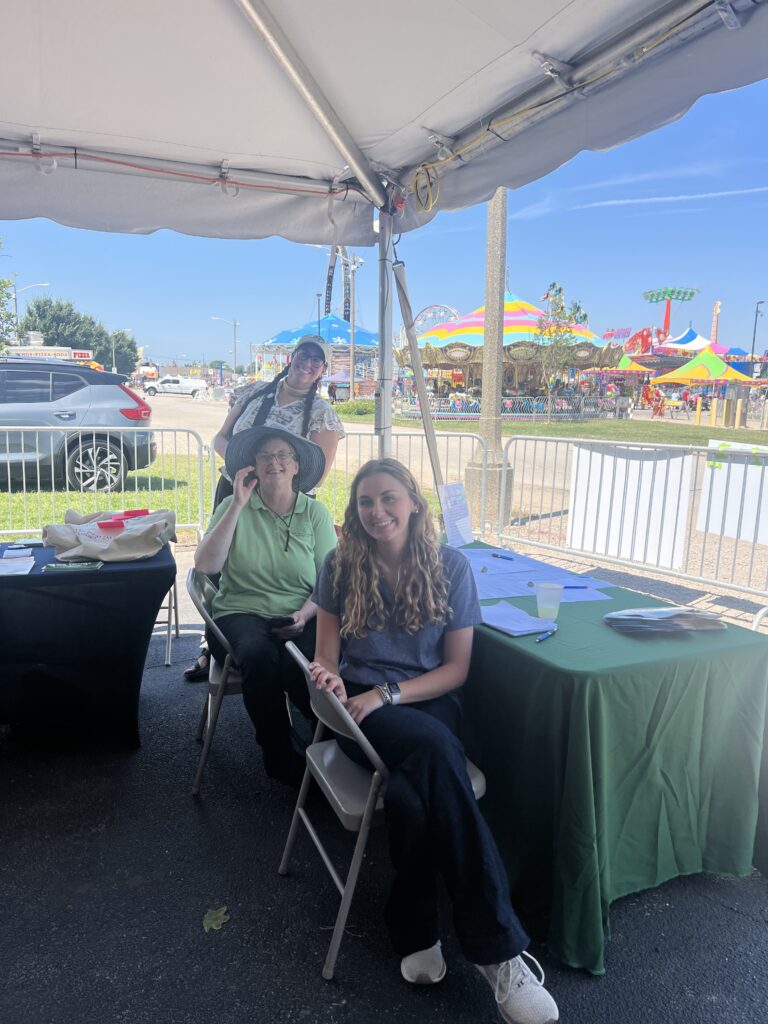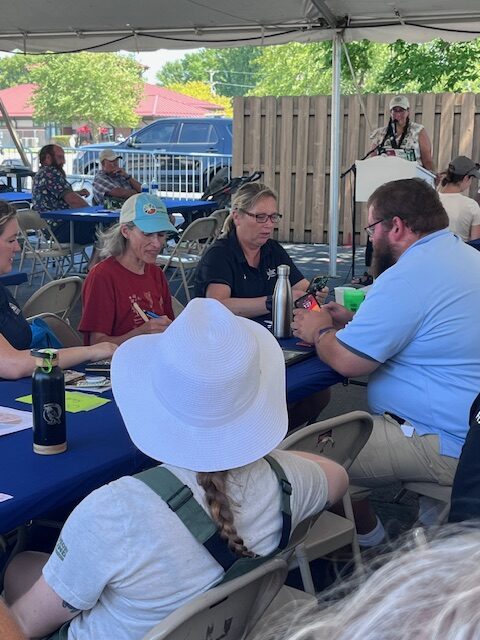Written by: Lisa Martin and Rachel Lechuga
Very hot weather on Ag Day at the Illinois State Fair did not deter a dedicated group of conservationists from enjoying the opportunity to reflect on their hard work over the years in the conservation agriculture space. Attendees networked over a delicious meal, participated in fun trivia and face painting, and shared their commitment to sustainable agriculture practices at the Cultivating Connections luncheon at the Illinois State Fair on Friday, August 8, 2025.

ISAP members, Lisa Martin (Certified Crop Adviser), Shani Goloval (Illinois Nutrient Research & Education Council) , and Jean Brokish (American Farmland Trust) show off their cover crop t-shirts and face painting!
Sponsor Christine Cliff of Midwest Dairy opened the event with some Dairy Trivia, which proved to be educational and maybe a bit simpler than the competitive Nutrient Loss Reduction Strategy (NLRS) trivia contest held at the end of the day. Attendees learned that dairy farmers typically recycle water on the farm up to four times and on average, milk travels 300 miles from the farm to the store. Upon check-in, attendees were assigned to different cover crop tables to get to know new folks and enjoyed networking over a lunch of chicken, hot dogs, salad, and coleslaw. During the lunchtime, they participated in networking bingo, designed with questions to bring the professionals together to find overlap in their work and personal lives.

Conservation ag champions gather for a delicious lunch and networking.
Following lunch and the networking activity, Rachel Lechuga, Midwest Outreach Specialist with American Farmland Trust, introduced members of the Illinois Sustainable Ag Partnership (ISAP) to share their reflections on ten years of NLRS. Jean Brokish, Treasurer of ISAP and Midwest Deputy Director at American Farmland Trust, shared the brief and impactful story of how ISAP was founded. Jean shared that following the release of the Nutrient Loss Reduction Strategy ten years ago, three women got together to share their worries for upcoming challenges to meet the strategy goals. From this conversation, the women leaned into the power of collaboration and said, “Let’s Work Together.” This networking event encapsulates the spirit that made ISAP possible nearly ten years ago. Today, ISAP continues to grow and has become a strong statewide partnership for sustainable agriculture and profitable farms in Illinois.

ISAP members, Kaitie Adams (Savanna Institute), Jean McGuire (The Wetlands Initiative), and Nicole Haverback (University of Illinois Extension) all participate on ISAP’s Network of Practitioners Working Group and share in the spirit of collaboration by helping to host events like this one.
Various ISAP members shared their reflections starting with Natalie Kerr, Illinois STAR Coordinator. Natalie shared information about the STAR (Saving Tomorrow’s Ag Resources) Program, which is now in 14 states. ISAP member Julie Hewitt of the Nutrient Research and Education Council (NREC) educated attendees on the progress being made through the many university level research projects being funded through fertilizer tonnage assessments. Many of the projects directly benefit growers and the environment by helping them manage nutrient efficiency in the field and work to capture excess nutrients with infield and edge of field practices. Eliot Clay of the Association of Soil and Water Conservation Districts and Amelia Cheek of Illinois Farm Bureau also shared information about their organizations and why they believe ISAP is a valuable organization making a difference on nutrient issues in Illinois.
Following the partners short presentations, it was time to test the knowledge of NLRS. Some great camaraderie and competition was displayed as the groups tried to answer some easy and more difficult trivia questions about the NLRS. Questions included some easy and hard questions such as when NLRS was established (2015), the size of the hypoxic zone (approximately 4400 square miles), and how many states have a nutrient reduction strategy (14). Many brains were busted as attendees struggled to identify the names of the hosts of The Illinois Nutrient Loss Reduction Strategy Podcast (Rachel Curry and Nicole Haverback). For more information on NLRS, visit their podcast to learn about current efforts to reduce nutrients in Illinois waterways.

Kaitie Adams of Savanna Institute played bar-trivia host! Kaitie challenged conservation ag professionals to test their NLRS knowledge.
The event wrapped up by 2pm with a drawing for an RTIC cooler filled with ISAP swag and generous donations from ISAP member organizations. Midwest Dairy graciously offered complimentary tickets for ice cream in the dairy barn for attendees. Following the event, the evaluations showed a continued interest in hosting this networking event again and a wave of positive feedback. Thank you to all who joined and participated!
As part of ISAP’s Alphabet Soup branch of the Network of Practitioners program pillar, ISAP’s Alphabet Soup program provides training and networking opportunities for agronomists, researchers, educators, conservation practitioners, and industry partners. Events include workshops, webinars, and happy hours where members explore issues, discuss strategies and program needs, and share resources related to nutrient loss reduction and conservation practices. If you are interested in joining the next Alphabet Soup gathering, please fill out the request form to stay up to date on upcoming Alphabet Soup events.